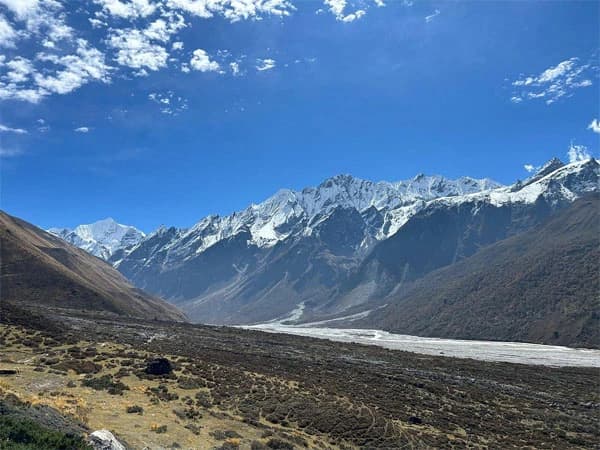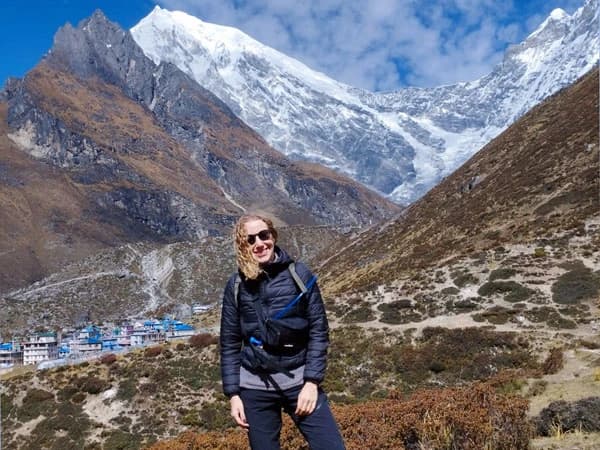Trekking Permits: Essential Documents
Every trekker needs two permits, both obtainable in Nepal Tourism Board Office in Kathmandu or via registered agencies.
Langtang National Park Entry Permit which costs NPR 3,000 (≈ $23) per person.
TIMS (Trekkers’ Information Management System) Card which costs NPR 2,000 (≈ $15) for solo trekkers; NPR 1,000 ($8) for groups.
The trekking permits ensures safety of the trekkers by tracking them. It will cost $30–$38 per person to get this permit. You should carry pp sized photos and nepali cash in order to obtain these permits.
Pro Tips: Avoid scams by purchasing permits directly from the Nepal Tourism Board.
Transportation: Getting to the Trailhead
The adventure starts with a journey from Kathmandu to Syabrubesi (the trek’s starting point). You can choose your transportation according to your preferences and budget. It is cheaper to go by local bus, bearable by shared jeep and expensive if you want to hire a private jeep. Let’s take a look at the cost details of various way of transportation during your Langtang trek:
By Local Bus
- Cost: $6–$8 (NPR 800–1,000) for a 7–9-hour ride.
- Details Buses leave early from Maccha Pokhari Bus Park. Expect basic seating and frequent stops.
By Shared Jeep
- Cost: $20–$25 per person (shared among 6–8 travelers).
- Advantage: Faster (6–7 hours) and more comfortable than buses.
Private Jeep
- Cost: $180 for the entire vehicle.
Pro tips
Book jeeps through your hired trekking agency for reliability and leave early to avoid midday traffic on Nepal’s winding mountain roads.
Accommodation: Tea House Costs
You will be accommodated at the tea house while trekking and at a 3-star hotel in Kathmandu. Tea houses are basic and affordable during your trek journey in Langtang region. But as altitude rises the price for even basic accommodation gets higher due to its remoteness. It will cost you $30-$40 for 7-10 nights stay at various places and altitudes. Most of the tea houses offer free lodging if you eat dinner and breakfast at the same place. Let’s take a brief look at the cost for accommodation at various elevations:
Lower Elevations (Syabrubesi, Lama Hotel)
- Cost $2–$4 per night for a twin-share room.
- Facilities: Shared toilets, cold showers.
Mid-Elevations (Langtang Village)
Higher Elevations (Kyanjin Gompa)
- Cost: $5–$8 per night.
- Facilities: Some offer attached bathrooms (extra $2–$3).
Food & Drinks: Daily Meal Expenses
During the Langtang Valley Trek you will get all types of basic and hearty meals. The most common food during the trekking expenditure is dal bhat which consists of vegetables, lentils soup rice and pickles. The food is your biggest daily cost. The cost for snacks might be very expensive as you climb higher so, it is better to carry it from Kathmandu. Menus are similar across tea houses, let’s take a look on foods and their cost throughout the trek:
Breakfast
- Pancakes/Oatmeal: $3–$4.
- Tibetan Bread with Honey: $2.
- Tea/Coffee: $1–$2.
Lunch/Dinner
- Dal Bhat (rice, lentils, veggies): $5–$7 (unlimited refills!).
- Noodles/Pasta: $4–$6.
- Momo (dumplings): $4–$5.
Snacks & Water
- Chocolate Bars: $2–$3.
- Boiled Water: $1–$2 per liter (cheaper with purification tablets).
- Bottled Water: $2–$4 (avoid plastic—carry a reusable bottle!).
- Daily Food Budget: $20–$30.
Guide & Porter Fees: Safety and Support
Langtang region trek doesn’t have mandatory guide and porter requirement but hiring them enhance safety and reduce strain. You should hire a licensed guide and porter in order to have a comfortable journey ahead. A guide will help you navigate way and handle permits at various checkpoints offering you a hassle free journey. Whereas hiring a porter will let you trek without heavy bags and comfortably. Here’s given cost for hiring guide and porter during the Langtang Trek:
Guides
- Cost $25–$35 per day.
- Role: Navigate trails, arrange lodging, and share cultural insights.
Porters
- Cost: $15–$25 per day (carries 15–20kg).
- Ethical Tip: Ensure your porter’s load doesn’t exceed 25kg.
Gear Rental: Affordable Options in Kathmandu
You must have proper Gear to trek the Langtang Valley in Nepal. As the weather in mountains are unpredictable you should pack layers of clothes. It is better to rent gears like sleeping bag and down jackets as you will need it just for the trek. Renting these belongings costs cheaper compared to buying it new. It might cost $50-$100 to rent these for 7-10 days. The cost for renting are given below:
- Sleeping Bag (4-season): $1–$3 per day.
- Down Jacket: $1–$3 per day.
- Backpack (60L): $2–$5 per day.
Miscellaneous Expenses
Travel Insurance is must have document while trekking and going for adventurous journeys in Himalayas of Nepal. You must get a travel expenses which covers all types of emergency evacuations and necessary arrangements. It might cost $100–$200 for a travel insurance ensuring covers of altitudes up to 5,000m and emergency evacuation. Here is given the costing of Miscellaneous Expenses:
Tipping
- Guides: $5–$10 per day.
- Porters: $3–$5 per day.
- Wi-Fi/Charging:
- Wi-Fi Cards: $3–$5 per hour in Kyanjin Gompa.
- Charging Devices: $1–$3 per hour.
- Hot Showers: $3–$5 (higher elevations).
Total Trek Cost Estimates
The cost for the Langtang Valley Trek may depend on various factors like season, hired trekking agency, and your comfort. If you are a budget traveler and wanting to trek solo without any guide it may cost $400–$600 for 7-10-day trek. If you plan to go solo it might be difficult for you as you will have to manage everything on your own. This is more adventurous and cheaper way to trek the Langtang Valley.
If you are wanting to trek remote and raw Langtang valley in budget friendly and comfortable way you can choose the Mid-range package. It offers a guide and porter service with comfortable stays. You will have basic meals and accommodations at tea houses. The cost for this package rises from $700–$1,200.
Luxury Langtang Trek is a comfortable way to trek in this remote, raw, and natural Langtang valley. This offers a comfortable lodges/teahouses stays with private rooms and hot showers. This offers you a chance to explore the beauty of Himalayas without compromising comfort. The cost for this trek costs $1,500+ as it is hard to get these facilities and services in remote and Himalayan areas of Nepal.
Note: Always carry an extra $200–$300 for delays, gear replacements, or health issues.
Why Langtang Valley Beats Other Treks?
Langtang Valley often stands out compared to other treks in Nepal for several compelling reasons. It is one of the closest trek from Kathmandu. It takes 6-7 hours of drive from Kathmandu to reach the trek starting points. This region sees fewer trekkers offering quieter and less commercial trekking trails. This trek is 30-50% less expensive than EBC and ABC trek.
Langtang Valley Trek is one of the most cost effective treks in Nepal, making it an excellent choice for the budget conscious adventurers. Unlike Everest and Annapurna region this region doesn’t require an expensive flight. The trek itself is shorter in duration which means you spend less on food lodging and gear rental. The cost for permits are also lower as you just have to get TIMS card and Langtang National Park Entry permit.
Tea houses along the trail are generally more affordable than those in high traffic areas. This trek can be done in nearly half of the price of EBC trek while still offering incredible mountain views, glacier hikes, and in immerse experience in tamang culture. Langtang is hidden gem that delivers the full Himalayan experience without draining your wallet.
Note
- Affordability: Costs 30–50% less than Everest or Annapurna.
- Culture: Meet Tamang and Sherpa communities in villages like Mundu.
- Scenery: Panoramic views of Langtang Lirung (7,227m) and yaks grazing in alpine meadows.
Final Tips for a Cost-Effective Trek
- Travel Off-Season during April–May and October–November are peak; December–March offers lower prices.
- Bargain Politely and negotiate gear rentals and jeep fares in Kathmandu.
- Carry Cash as ATMs are scarce beyond Syabrubesi.
- Take the Local Bus: Instead of private jeep to Syabrubesi, take the public bus from Kathmandu as it is cheaper.
- Bring a water purification tablets as bottled water is expensive and purification helps to save money and reduce plastic waste.
- Trek in group to save money and it can make your journey fun and budget friendly.
- Bring your snacks as food gets more expensive as you climb higher.





